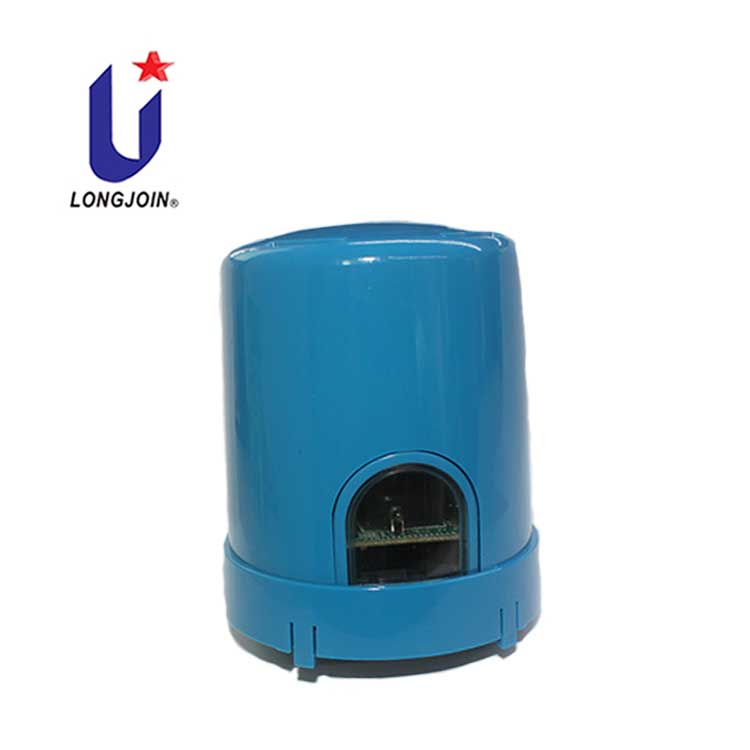Sensores com filtro R versus sensores infravermelhos: como as fotocélulas se mantêm confiáveis na iluminação pública de LED.
Introduzir
Outdoor lighting has become smarter and more efficient with the rise of LED street lights. However, a subtle but persistent problem affects how these lights respond to daylight — photocell misoperation. The root cause often lies in the type of sensor used.
This article explores how different photocell sensors—from conventional to R-filtered and IR sensors—perform under modern lighting conditions, and how Eletrônica de junção longa ensures stable dusk-to-dawn control through advanced design.

Why Does the Sensor Matter in a Photocell?
Do your street lights come on too early or blink all night long? The cause is a small, very vital sensor fotoelétrico hidden deep inside the photocell.
A photocell for street light acts as the “eye” of your lighting control system. It detects ambient light levels and automatically switches the street light on at dusk and off at dawn — hence the term dusk-to-dawn photocell.
But today’s LED age brings a new test for photocells. LED bulbs shine in ways unlike old sodium or metal halide lamps. Their narrow spectral output can confuse older photocell designs, leading to:
- False triggering: when the photocell“sees” its own LED light and turns off too soon.
- On/off cycling: when lights repeatedly switch on and off near the boundary of dusk or dawn.
- Infrared interference: causing unstable performance or delayed response.
That’s why modern lighting systems require smarter sensor technologies that can handle LED spectral behavior
Problema | Traditional Cause | Effect on LED Street Lights |
False triggering | Over-sensitive visible light detection | Lights turn off too early |
On/off cycling | Proximity to lamp | Constant switching damages lamp and circuit |
IR interference | Unfiltered IR light | Unstable brightness control |
To solve this, engineers introduced R-filtered and IR sensors—innovations that make photocells far more reliable under LED conditions.
What Is an R-Filtered Photocell Sensor and How Does It Work?
Have you ever noticed some photocells perform better under LED light? That’s because of the R-filtered sensor design.
An R-filtered photocell sensor has a red-infrared filter inside. It blocks extra infrared rays and lets only visible light pass through. It helps the photocell act like the human eye. It ignores false infrared signals.
Veja como funciona:
- The filterremoves IR wavelengths emitted by LEDs or other heat sources.
- The sensormeasures the visible light intensity accurately.
- The control circuit switches the light based on actual environmental brightness, not reflections.
Why R-Filtered Sensors Are Ideal for LED Lighting
R-filtered photocells shine in urban and residential projects where LEDs dominate. They offer:
- Stable dusk-to-dawn control unaffected by lamp proximity.
- Accurate sensitivity aligned with human vision.
- Energy savings through precise switching.
Recurso | R-Filtered Photocell Sensor |
Detection Range | Visible light spectrum (380–780 nm) |
Main Advantage | Mimics human eye response |
LED Compatibility | Excelente |
Aplicativo | Municipal, park, and residential areas |
Example Models | JL-428C, JL-207 |
Still, R-filtered designs can be sensitive. Mount them under a lamp, and strong reflections make it worse. In such cases, engineers often turn to IR sensors.

How Do IR Sensors Improve Stability in Photocells?
When your photocell is installed too close to the lamp, standard filters can struggle. That’s where IR sensors come in.
An IR (Infrared) sensor detects infrared light only, completely ignoring visible light. This makes it immune to the visible LED output that causes self-triggering or flicker loops.
How it works:
- It tracks only IR radiation, usually emitted from the natural environment or sky.
- It filters out visible LED light completely.
- It ensures the light photocell switch operates purely based on daylight conditions, not its own light source.
This design is ideal for photocells mounted under the luminaire or in reflective environments like tunnels, high poles, or metallic lamp housings.
Recurso | IR Photocell Sensor |
Detection Range | Infrared spectrum (above 780 nm) |
Vantagem | Unaffected by LED reflections |
Limitation | Less natural to human-eye response |
Aplicativo | Under-lamp or reflective areas |
Example Models | JL-203C Series, JL-205 Series |
By integrating IR-only detection, manufacturers can produce high-stability photocontrol receptacles that keep LED street lights operating flawlessly all night.
How Do R-Filtered and IR Sensors Compare in Real Projects?
Choosing between R-filtered and IR sensors depends on your installation conditions. The table below summarizes their differences and ideal scenarios.
Tipo de sensor | Princípio de funcionamento | Vantagens | Limitações | Best Use | Long-Join Models |
Conventional | Detects visible + IR | Baixo custo | Affected by LED reflections | Gardens, general lighting | JL-101 / JL-102 / JL-106 |
R-Filtered | Filters IR, reads visible light | Mimics human eye, LED-friendly | Sensitive under lamp | Parks, municipal roads | JL-202 / JL-204 / JL-207 |
IR Sensor | Reads IR only | Immune to LED self-trigger | Needs special circuitry | Under-lamp, tunnels | JL-203C / JL-205 |
For smart street lighting systems, the IR approach often wins due to its zero false trigger rate and high noise immunity. But for aesthetic public lighting, R-filtered sensors provide a more “natural” on/off rhythm matching human perception.

What Makes Long-Join’s Photocell Designs Stand Out?
Eletrônica de junção longa has over 20 years of experience. It is one of the most trusted manufacturers of photocells for Iluminação pública LED and intelligent control systems.
Our engineers aim for real-world performance. Every photocontrol stays reliable through changing weather, voltage swings, and installation differences.
Long-Join’s core photocell solutions include:
1. JL-428C Series
- Equipped with IR-filtered photodiodes
- Hybrid thermal + electronic circuit for durability
- Integrado MOV surge protectionfor lightning safety
- Ideal for LED street lights and industrial-grade systems
2. JL-207 Series (Next Generation)
- Improved optical filtering
- Enhanced accuracy for LED detection
- Perfect for smart city projects and NEMA-compatible systems
Each product is tested under IP65 waterproof standards, vibration conditions, and long-term UV exposure—ensuring your photocell lasts for 30,000+ switching cycles without drift.
For more on our IR-filtered designs, explore:
- Long-Join JL-205 Photocell
- Smart Street Lighting Controllers
How Does a Photocell Enhance Smart Street Lighting Efficiency?
Still wondering how these small devices transform city lighting systems?
A photocell lighting sensor reduces manual maintenance by automatically managing light cycles. When integrated into a smart lighting control network, it helps:
- Cut energy use by 30–40%
- Extend LED lifespan by avoiding unnecessary cycles
- Lower maintenance costs with automatic diagnostics
Modern photocells connect via NEMA ou Soquetes Zhaga, allowing modular upgrades to intelligent controllers. Long-Join’s designs include both 7-pin NEMA receptacles e 4-pin Zhaga connectors, compatible with global smart city standards.
Recurso | NEMA Photocontrol Receptacle | Soquete Zhaga |
Pins | 3–7 | 4 |
Aplicativo | Outdoor street light controller | Compact smart luminaires |
Exemplo | NEMA JL-700 Series | Zhaga JL-700Z |
This flexibility allows municipalities to upgrade existing systems without replacing entire fixtures.
What Should You Consider When Selecting a Photocell for Street Light Projects?
Selecting the right light sensor switch goes beyond price. Consider these factors:
- Installation Position– Under-lamp setups perform best with IR sensors.
- Environmental Light Conditions– For open roads or parks, R-filtered sensors ensure accurate response.
- Smart Control Integration– Choose NEMA or Zhaga-compatible photocells for IoT systems.
- Certificações – Always verify UL, CE, and ANSI C136.10/41 compliance.
With these considerations, Long-Join helps cities, OEMs, and lighting integrators achieve stable, cost-effective lighting automation.
Conclusão
As LEDs dominate urban lighting, sensores de fotocélula must evolve. Traditional designs no longer suffice. Whether your project requires human-eye precision or infrared stability, Long-Join Electronics provides the expertise and technology for consistent, intelligent light control.
De fotocélulas do anoitecer ao amanhecer para smart photocontrol receptacles, Long-Join continues to lead in reliability, innovation, and sustainability for the global lighting industry.
Links externos:
●https://www.electronicsforu.com/technology-trends/learn-electronics/ir-led-infrared-sensor-basics
●https://www.sciencedirect.com/science/article/abs/pii/S0030399204001677
●https://en.wikipedia.org/wiki/Photodiode
●https://electronics.stackexchange.com/questions/640162/how-do-movs-work-for-surge-protection
●https://premioinc.com/blogs/blog/what-is-ip65-rating-ip65-waterproof-protection





